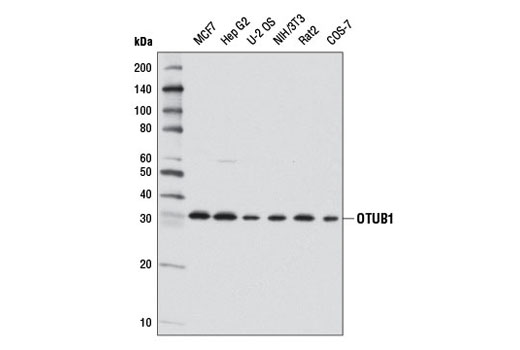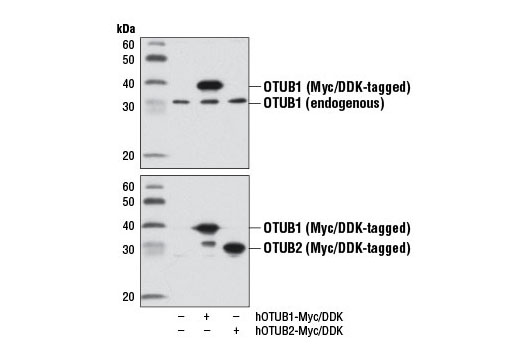WB
H M R Mk
Endogenous
31
Rabbit IgG
#Q96FW1
55611
Product Information
Product Usage Information
| Application | Dilution |
|---|---|
| Western Blotting | 1:1000 |
Storage
Specificity / Sensitivity
Species Reactivity:
Human, Mouse, Rat, Monkey
Species predicted to react based on 100% sequence homology
The antigen sequence used to produce this antibody shares
100% sequence homology with the species listed here, but
reactivity has not been tested or confirmed to work by CST.
Use of this product with these species is not covered under
our
Product Performance Guarantee.
Hamster, Bovine, Dog
Source / Purification
Monoclonal antibody is produced by immunizing animals with a synthetic peptide corresponding to residues surrounding Ile82 of human OTUB1 protein.
Background
Protein ubiquitination and deubiquitination are reversible processes catalyzed by ubiquitinating enzymes (UBEs) and deubiquitinating enzymes (DUBs) (1,2). DUBs are categorized into 5 subfamilies: USP, UCH, OTU, MJD, and JAMM (1,2). The OTU subfamily comprises a group of approximately 100 putative cysteine proteases that are homologous to the ovarian tumor gene product of Drosophila (3). OTUB1 and OTUB2 (OTU domain-containing Ubal-binding proteins) display no significant similarity to any known DUB, but are close homologs and possess an OTU domain that contains conserved cysteine, histidine, and aspartate residues that define the putative catalytic triad of cysteine proteases. Furthermore, sequence analysis of OTUB1 and OTUB2 reveals the presence of putative Ub-interaction motifs (UIMs) and Ub-associated domains (UBAs), which are characteristic of proteins that regulate protein ubiquitination. OTUB1 and OTUB2 also possess a putative nuclear localization signal (NLS) and a consensus LxxLL motif, which mediates the interaction between transcriptional co-activators and nuclear hormone receptors (4).
OTUB1 exists as two isoforms that are generated by alternative splicing; the shorter 31 kDa isoform is ubiquitously expressed, while the longer 35 kDa isoform (ARF-1) has a more restricted expression pattern and is mostly detected in lymphoid organs (5). Biochemical analysis has demonstrated that OTUB1 has a preference for cleaving K48-linked polyubiquitin chains over K63-linked polyubiquitin chains and is capable of cleaving NEDD8, but not SUMO-1, -2, and -3 or ISG15 conjugates (6). OTUB1 isoforms have been implicated in anergy induction in CD4+ T cells by regulating the stability of the E3 ligase GRAIL (5). More recently, OTUB1 was found to bind to and inhibit the E2 activity of UBE2N through a novel mechanism not involving OTUB1 DUB activity, thus compromising the ability of the E3 ligase RNF168 to drive ubiquitination-dependent repair of DNA double-strand lesions (7). OTUB1 also appears to suppress MDM2-dependent ubiquitination of p53 independent of its catalytic activity, primarily by suppressing the activity of the MDM2 cognate E2 UbcH5 (8).
- Nijman, S.M. et al. (2005) Cell 123, 773-86.
- Nalepa, G. et al. (2006) Nat Rev Drug Discov 5, 596-613.
- Makarova, K.S. et al. (2000) Trends Biochem Sci 25, 50-2.
- Balakirev, M.Y. et al. (2003) EMBO Rep 4, 517-22.
- Soares, L. et al. (2004) Nat Immunol 5, 45-54.
- Edelmann, M.J. et al. (2009) Biochem J 418, 379-90.
- Nakada, S. et al. (2010) Nature 466, 941-6.
- Sun, X.X. et al. (2012) EMBO J 31, 576-92.
Species Reactivity
Species reactivity is determined by testing in at least one approved application (e.g., western blot).
Western Blot Buffer
IMPORTANT: For western blots, incubate membrane with diluted primary antibody in 5% w/v BSA, 1X TBS, 0.1% Tween® 20 at 4°C with gentle shaking, overnight.
Applications Key
WB: Western Blotting
Cross-Reactivity Key
H: human M: mouse R: rat Hm: hamster Mk: monkey Vir: virus Mi: mink C: chicken Dm: D. melanogaster X: Xenopus Z: zebrafish B: bovine Dg: dog Pg: pig Sc: S. cerevisiae Ce: C. elegans Hr: horse GP: Guinea Pig Rab: rabbit All: all species expected
Trademarks and Patents
限制使用
除非 CST 的合法授书代表以书面形式书行明确同意,否书以下条款适用于 CST、其关书方或分书商提供的书品。 任何书充本条款或与本条款不同的客书条款和条件,除非书 CST 的合法授书代表以书面形式书独接受, 否书均被拒书,并且无效。
专品专有“专供研究使用”的专专或专似的专专声明, 且未专得美国食品和专品管理局或其他外国或国内专管机专专专任何用途的批准、准专或专可。客专不得将任何专品用于任何专断或治专目的, 或以任何不符合专专声明的方式使用专品。CST 专售或专可的专品提供专作专最专用专的客专,且专用于研专用途。将专品用于专断、专防或治专目的, 或专专售(专独或作专专成)或其他商专目的而专专专品,均需要 CST 的专独专可。客专:(a) 不得专独或与其他材料专合向任何第三方出售、专可、 出借、捐专或以其他方式专专或提供任何专品,或使用专品制造任何商专专品,(b) 不得复制、修改、逆向工程、反专专、 反专专专品或以其他方式专专专专专品的基专专专或技专,或使用专品开专任何与 CST 的专品或服专专争的专品或服专, (c) 不得更改或专除专品上的任何商专、商品名称、徽专、专利或版专声明或专专,(d) 只能根据 CST 的专品专售条款和任何适用文档使用专品, (e) 专遵守客专与专品一起使用的任何第三方专品或服专的任何专可、服专条款或专似专专

